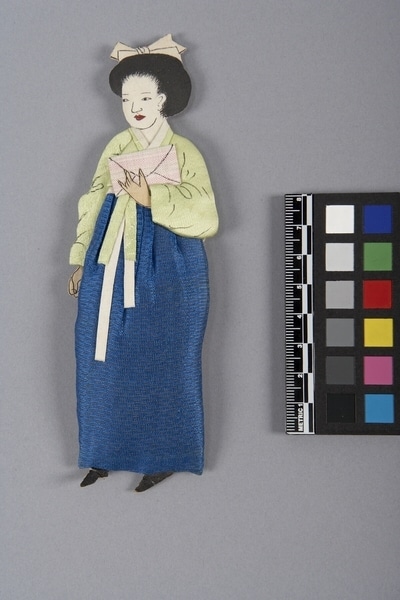Doll Item Number: Ed1.121 from the MOA: University of British Columbia

Description
Figure representing a person on a flat backing of white paper. Front view is depicted of the figure which is made of cloth lightly padded to give a thee-dimensional effect having each portion made of a separate piece of cloth with painted details. Hands are made of paper. Face is made of white silk. Figure's left hand is holding a rectangular object of light red silk. White bow on the head. Wearing a short yellow-green silk blouse, a blue skirt fastened under the arms with a white cotton ribbon, white socks, and black shoes. Two pieces of white flannel hemmed with light red-pink silk thread with a loop of the same at the top are sewn to the paper backing.
History Of Use
Figure represents woman of late 19th to early 20th centuries. Such figures were made during the time when Korea was first open to the outside world (after the mid 1890s), probably as gifts to present to missionaries or other visitors from foreign countries. Flat dolls like these were very popular during the period 1910-20. Before that time, shamans made dolls that they sold to their clients, as images of those the clients wanted to exorcise. Simple dolls were made of straw for children to play with. After Korea opened, people began to see dolls as artistic objects. They were made in workshops by masters, using authentic fabrics whenever possible, as their purpose was to introduce foreigners to Korean society. During the 1920s-30s some women, such as the wives of missionaries or female students, would dress in this way. They were called modern women, “Shin-yo-sung”. Western style socks became available, so that they could wear western shoes, probably high shoes with laces.. Western style handbags, made in factories, also became available and were used by them instead of the small Korean waist pouches. They wore their hair in a bouffant style called “Ta-rae-mori” (pompadour), influenced by Japanese or western styles. Their jackets “Jo-go-ri” became longer than previously, with wide, rounded sleeves.
Narrative
Collected by J. H. Morris while he was chief engineer for Seoul Railway, Korea.
Specific Techniques
The clothing was stitched around the edge and then a layer was added inside the clothing. Each section was separately applied and pasted in place. The details were finely painted.
Iconographic Meaning
The relatively long skirt “chi-ma” shows that the woman is married. A female student would wear a slightly shorter skirt.
Item History
- Made in Korea during 1910
- Collected between 1910 and 1939
- Owned by Marion Stephan before August 1964
- Received from Marion Stephan (Donor) during August 1964
What
- Name
- Doll
- Identification Number
- Ed1.121
- Type of Item
- doll
- Material
- paper, silk fibre, cotton fibre, rayon fibre ?, paint and paste adhesive
- Manufacturing Technique
- spun, woven, cut, painted, sewn and pasted
- Overall
- height 15.8 cm, width 5.2 cm, depth 0.8 cm
Who
- Culture
- Korean
- Previous Owner
- Marion Stephan
- Received from
- Marion Stephan (Donor)
Where
- Holding Institution
- MOA: University of British Columbia
- Made in
- Korea
When
- Creation Date
- during 1910
- Collection Date
- between 1910 and 1939
- Ownership Date
- before August 1964
- Acquisition Date
- during August 1964
Other
- Condition
- good
- Current Location
- Case 77
- Accession Number
- 0113/0024